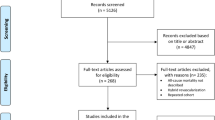Abstract
The SYNTAX study randomized patients (pts) with three-vessel or left main coronary artery disease (CAD) into pts who underwent bypass grafting (CABG) or percutaneous coronary intervention (PCI). The primary endpoint of the study was a major adverse cardiac or cerebrovascular event (death from any cause, stroke, myocardial infarction, repeated revascularization)(MACCE). Rates of MACCE at 12 months were significantly higher in the PCI group (17.8%) than in the CAGB group (12.4%, p < 0.002). This was caused by an increased rate of repeated revascularizations in PCI pts (13.5%) compared to CABG pts (5.9%, p < 0.001). The rates of death and myocardial infarction were similar between the two groups. Stroke was significantly more likely to occur with CABG (2.2%) versus 0.6% with PCI (p = 0.003). Despite the results of the SYNTAX study, an individual strategy is necessary for each patient.


Similar content being viewed by others
References
Barner HB (2008) Operative treatment for coronary atherosclerosis. Ann Thorac Surg 85:1473–1482
Birnbaum Y, Drew BJ (2003) The electrocardiogram in ST elevation acute myocardial infarction: correlation with coronary anatomy and prognosis. Postgrad Med J 79:490–504
Booth J, Clayton T, Petter J et al (2008) Randomized, controlled trial of coronary artery bypass surgery versus percutaneous coronary intervention in patients with multivessel coronary artery disease: six-year follow-up from the Stent or Surgery Trial (SoS). Circulation 118:381–388
Bravata DM, Gienger AL, McDonald KM et al (2007) Systematic review: the comparative effectiveness of percutaneous coronary interventions and coronary artery bypass graft surgery. Ann Intern Med 147:703–716
Brener SJ, Galla JM, Bryant R III, Sabik JF III, Ellis SG (2008) Comparison of percutaneous versus surgical revascularization of severe unprotected left main coronary stenosis in matched patients. Am J Cardiol 101:169–172
Brigouri C, Condorelli G, Airoldi F et al (2007) Comparison of coronary drug-eluting stents versus coronary artery bypass grafting in patients with diabetes mellitus. Am J Cardiol 99:779–784
Daemen J, Boersma E, Flatheter M et al (2008) Long-term safety and efficacy of percutaneous coronary intervention with stenting and coronary artery bypass surgery for multivessel coronary artery disease: a metaanalysis with 5-year patient-level data from the ARTS, ERACI-II, Mass-II, and SoS trials. Circulation 118:1146–1154
Favoloro RG 1968) Saphenous vein autograft replacement of severe segmental coronary artery occlusion: operative technique. Ann Thorac Surg 5:334–339
Fiol M, Cygankiewicz I, Carillo A et al (2004) Value of electrocardiographic algorithm based on “ups and downs” of ST in assessment of a culprit artery in evolving inferior wall acute myocardial infarction. Am J Cardiol 94:709–714
Flynn M, Reddy S, Shepherd W et al (2004) Fast-tracking revisted: routine cardiac surgical patients need minimal intensive care. Eur J Cardiothorac Surg 25:116–122
Grüntzig A (1978) Transluminal dilatation of coronary-artery stenosis. Lancet 1:63
Hamm C (2009) SYNTAX-Studie. Nichts Neues am Kathetertisch. Kardiologe 3:294–295
Hannan EL, Wu C, Walford G et al (2008) Drug-eluting stents vs. Coronary-artery bypass grafting in multovessel coronary artery disease. N Engl J Med 358:331–341
Janssen DP, Noyes L, Wouters C, Brouwer RM (2004) Preoperative prediction of prolonged stay in the intensive care unit for coronary bypass surgery. Eur J Cardiothorac Surg 25:203–207
Serruys PW, Kutryk MJB, Ong ATL (2006) Coronary-artery stents. N Engl J Med 354:483–495
Serruys PW, Morice MC, Kappestein AP et al (2009) Percutaneous coronary intervention versus coronary-artery bypass grafting for severe coronary artery disease. N Engl J Med 360:961–972
Smith SC Jr, Feldman TE, Hirshfeld JW Jr et al (2006) ACC/AHA/SCAI 2005 guideline update for percutaneous coronary intervention: a report of the American College of Cardiology/American Heart Association Task Force on Practice Guidelines (ACC/AHA/SCAI Writing Committee to Update the 2001 Guideline for Percutaneous Coronary Intervention). J Am Coll Cardiol 47:e1–e121
Stettler C, Wandel S, Allemann S et al (2007) Outcomes associated with drug-eluting and bare-metal stents: a collaborative network meta-analysis. Lancet 370:937–948
Yamaji H, Iwaschachi S, Kusachi S, Murkemi T, Hirami R et al (2001) Prediction of acute left main coronary obstruction by 12-lead electrocardiogram: ST segment elevation in lead aVR with less ST segment elevation in lead V1. J Am Coll Cardiol 38:1348–1354
Conflict of interest
The author declares that there is no conflict of interest.
Author information
Authors and Affiliations
Corresponding author
Rights and permissions
About this article
Cite this article
Trappe, HJ. The SYNTAX study. Clin Res Cardiol Suppl 5 (Suppl 1), 70–74 (2010). https://doi.org/10.1007/s11789-010-0004-0
Published:
Issue Date:
DOI: https://doi.org/10.1007/s11789-010-0004-0




